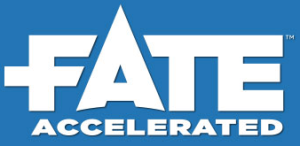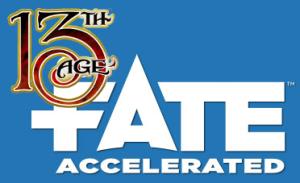Before we begin, for those who don’t know, a role-playing game (or RPG) is a way to tell stories as a group – one person sets the scene, the rest have characters described in terms of their attributes, skills, abilities and powers. One might play a fighter, wielding a magic sword to take down hordes of goblins. One might play a powerful wizard, hurling fireballs into the fray. Success and failure is determined by a collection of unusual-shaped dice and how high (or low) you roll. The grandfather of them all is Dungeons & Dragons (D&D), due for an upgrade this July. However, in the decades since it was released, it has seen hundreds of alternatives hit the shelves…

In my left hand I hold 13th Age. A beautiful, letter-sized hardback. Bound, colour-illustrated throughout, it contains the rules and game world for Pelgrane Press’s flagship fantasy roleplaying game. It’s roots are firmly in D&D – characters are described in terms of Strength, Dexterity, Constitution, etc., and have lists of talents, feats, powers, and so on.
13th Age has a number of tweaks that update D&D, streamlining things and involving players and their characters in creating the fine details of the game world. Many of these elements are modular in nature and can be lifted wholesale and applied to whatever game you’re playing. It’s also one of the best written RPG books I’ve had the pleasure to read, the conversational tone and frequent interjections by one or other of the developers in sidebars providing examples of how they do things.
I’ve blogged about 13th Age here before:
- 13th Age – Bring on the Elves
Problem with 13th Age is it hasn’t moved very far from it’s roots in D&D – 6 attributes, lists of talents and feats, much flicking around in the rulebook when creating characters for the first few times

In my right hand I hold Fate Accelerated Edition. My right hand has the far easier job. FAE is A5 or thereabouts, 48 pages long including index and character sheet and, on the virtual scales of balance, you’d need about 200 copies of FAE to balance 1 of 13th Age. It’s lightweight, story-driven gaming. Characters are described in terms not of Strength, Dexterity and the like but Careful, Clever, Flashy, Forceful, Quick and Sneaky. Instantly, on seeing the character sheet, you’ve got a much better idea of what sort of a character this is. You also have Aspects – puncy sentences that describe the sort of character you’re playing. “Hard-drinking Dwarf thug from the mines of M’Zark“, would be a decent “High concept” Aspect. It nicely describes, in a nutshell, what sort of character this is.
For picking up a game quickly and diving in, you don’t get a lot faster than FAE these days. You used to – the system from the old West End Games’ Ghostbusters International was even simpler and faster than this!
What you don’t get with FAE is a world to play in. And that’s where 13th Age comes in. You also need special dice with +, – and blank sides to roll. But then you need the whole range of dice for 13th Age. Chances are, as a gamer, you’ve already got both.
By taking elements of both games – the lightning-fast character creation and rule-set of FAE coupled with the world-embedding tweaks of 13th Age (and the general setting itself) you’ve got a near-perfect combination of simple rules and great world.

But I’m not quite finished yet. Bits of Dungeon World appeal to me – playbooks for the characters that stop you having to reference the rulebook so often (not that that’s a big deal with FAE), the way it describes campaigns and gets you to think things through… Z6 will feed into this little project as well.
That’s the problem with RPGs. Once you start tweaking it’s very hard to stop.
